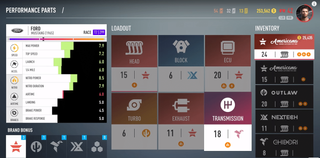The case for and against loot boxes, according to developers
How and why loot boxes make it into triple-A games, and what you can do about it.

The Year of the Loot Box hasn't had quite the same glamour as the Year of Luigi. Those were better times. Happier times. We didn't have to gamble on a 1 percent drop rate for a legendary green cap or pay $5 to replenish a stock of fire arrows. So how did we get here: How have loot boxes now become the go-to delivery mechanism for desirable videogame items in 2017, spreading from card games and Valve shooters like CS:GO and Team Fortress 2 into $60 blockbusters like Call of Duty: WWII and Star Wars Battlefront 2?
I asked developers who have worked on triple-A and indie games about the process behind how loot boxes are designed and implemented, plus what the future holds for microtransactions given the current player backlash against them. Here's what they had to say.
Why have we seen such a surge in loot boxes in 2017?
"I think there's a false narrative that runs around, when [companies] see growth somewhere, they think 'oh, we have to be part of this,'" a veteran producer of triple-A games, who asked to be quoted anonymously, told us. "[The impulse is] 'Oh god, let's put this in our game.' When in reality, you don't need to do that… There's definitely a mentality of 'oh god, we have to do something... Mobile is doing so well.'"
In his opinion, though, "Mobile and console/PC are not competing. They're fundamentally different spaces, and the consistent lines that are drawn need to stop being drawn."
Who decides whether loot boxes are going into a game, and when is that decision made?
This isn't directly on the subject of microtransactions, but there's a lot people don't understand about how videogames are made.
The same producer I talked to suggested, as you would expect, that systems like loot boxes are implemented into different games at different stages of development.
"I worked on a five year project, and certainly at the beginning of the project, that wasn't in the conversation," the producer said. "The publisher definitely brought it up 2-3 years out from release, it was at least talked about. There wasn't a set system put together for it, just an idea of how would we do this, what would we do, what could we sell that would be valuable to people, and in our case, [that the loot boxes] would not be gameplay-based."
I also talked over email with a designer who has experience at both triple-A and indie studios, who offered some examples of the design process. He too asked to be quoted anonymously.
The biggest gaming news, reviews and hardware deals
Keep up to date with the most important stories and the best deals, as picked by the PC Gamer team.
"The decision to include a certain type of microtransaction is typically made early in the project—you have to design and architect the game and its systems in such a way that you can support it. In my experience, it floated around as something that we knew we were going to implement at some point, but it was one of the last things that we actually built (which can mean a small window for iteration, especially when pushed up against a submission date)."
The designer said that in the example above, he was working on a multiplayer version of a game that already had a singleplayer mode, so the process may not be indicative of how microtransactions work in other projects. He elaborated on how the decision to implement a loot box system can differ between an indie and a triple-A project, but with the caveat that he had not worked on one of the latter with a loot box mechanic.

"The way that I've seen this go is that management (or, conceivably, the publisher) dictates A) that microtransactions/item drops will be included in the game, and B) what type of content will be available from that system. From there, the development team was integral to the decision process as we figured out exactly what the system would look like."
For the development team, this means meetings on everything to do with the items that go into the loot boxes. For skins, that means what they look like, what happens with duplicate items, drop rates, and more, with the goal of "finding a balance between meeting the financial goals of introducing the system, providing satisfying content that (some) players would get legitimately excited about, and not polluting the existing game with too much extraneous crap."
In this case, the designer was also involved in decisions about pricing and game bundles, but said "for the majority of companies, decisions about anything related to finances are above the paygrade of the development team."
"I will say, though, that at AAA companies that I've worked at, once a feature or system is determined to be necessary (either by leadership or by suggestion from a developer), the implementation thereof is handed off to developers. The developers are told what the goal of the system is, but how they realize that goal is generally up to them. At regular intervals, the system will be reviewed and the developer will receive feedback from leadership and have to make changes according to that feedback. Addressing the feedback that you get can sometimes mean making changes that you do not personally believe in, or even know to be a mistake (so that you can show the leadership that it was a mistake and that the concern can be handled in some other way). So, in a case like the loot boxes in Battlefront, it's nigh-impossible to suss out where it went sideways, since the developer is unable to speak out due to NDAs and not wanting to lose their job, and the company's spokesperson can't play the blame game either—all they can do is attempt to placate people who are upset."

Do big budget games need loot boxes to stay profitable?
The price of triple-A games is contentious. As Tyler wrote earlier this year, season passes and special editions mean many players are paying more than "just" $60 for a new game, which accounts for some of the inflation gamers have supposedly avoided over the past decade. Publishers also take a larger cut of digital game sales and pay lower overhead on inventory, making each sale more profitable. At the same time, as the veteran producer I spoke with noted, games are vastly more expensive to make than they once were.
A lower price would also mean that the oft-touted 'players who buy 1 or 2 games a year' could actually buy 3 or 4 games a year. These players are usually the justification for making a game as mainstream as possible.
"Halo 1 was developed I think by 35-50 people. That's tiny. Paying those people, making sure development is paid, is a lot easier than paying 300 people. That's eight, 10 times the cost. That's a big deal, that's a big change for a company. When you put something out and the world looks at it and the internet is filled with vitriol, if it's not good, you just took an enormous bet, and you just failed. And people end up losing their jobs."
Note that the Halo page on Mobygames lists about 80 staff for the game, not including voice talent but including testing and a number of other roles. Still, the point stands: look at how many people worked on Destiny 2, for comparison.
"This isn't directly on the subject of microtransactions, but there's a lot people don't understand about how videogames are made," the producer said.
"It's not like there's just creative vision and that's the only thing that holds. There's a lot of considerations that go into it. It's a painful, really hard process, and you lose a lot of people along the way. You don't want that. You want the external world, if they ever can, to understand that it's very difficult. But I think the second piece is, you want to have some compassion for development, and honestly publishers, too. Publishers have a business. They have to make money or they don't make any more games. The question is, what's the right way to do it? I don't know if [loot boxes] become the new norm. I personally hope not. I'd rather be able to pay for content."

The designer I talked with argued for a lower price for triple-A games, despite the rising cost of production.
"I actually think AAA games should cost less," he wrote. "For some people, the $60 cost is simply too much to manage, which either means a missed sale, or a sale of a used copy (which is one of the reasons that DLC is so prevalent). A lower price tag would make it accessible to a wider audience—a good thing for both players and developers. A lower price would also mean that the oft-touted 'players who buy 1 or 2 games a year' could actually buy 3 or 4 games a year. These players are usually the justification for making a game as mainstream as possible: by giving them more buying power, that might allow games to be truer to themselves, rather than pursuing the lowest common denominator (read: we developers get to make weird stuff).
"I think the $60 price point is also a large contributor to the phenomenon of games becoming bloated in service of 'giving the players their money's worth' (which, in turn, creates expectations of duration/game modes based on price point from the players' side). It's a toxic and self-propagating cycle that results in games that do not respect players' time and that take larger teams longer amounts of time to make (which then means they need to make more money in order to be viable)."

An EA developer I emailed with, with knowledge of the development of Need For Speed: Payback, had a similar opinion. He asked to be quoted anonymously. "Making a game from scratch is an immense effort (at least in my experience) and this is still a business, after all. As a player though, I actually think games should cost less," he said. "This is where studios like Ninja Theory step in and challenge the industry standard with AAA quality games, but lower price of entry."
Another common suggestion is that systems like loot boxes subsidize the price for other players, who don't want to pay.
"The trouble with that argument is the real risk that the game design fundamentally changes," the veteran producer said. "The game design is no longer about some Dark Souls-style gameplay or The Last of Us's story, it's about, 'how do we get people to spend money?' To change that, you're having a material effect on what you're doing. You become like a math machine that's job is to get money out of players, solely. The other stuff is window dressing. And that's a problem."
Triple-A vs. free-to-play loot boxes
Designer Damion Schubert, who's worked on numerous MMOs including Star Wars: The Old Republic, tweeted about the challenges of "ethical" loot boxes and "how annoying it is to watch AAA publishers fuck them up from the perspective of someone who has to design to them." A few highlights:
The Zynga Facebook games that used to spam your feed were a success if they had a conversion rate of 2%. That's right - a successful business model if 98% of your population never drops a dime. (4)November 15, 2017
Because that 90%+ of the population is your game's virality (also known as "word of mouth"). If your free players (or in the case of Battlefront, box spenders) have a negative reax it can kill word of mouth, tank reviews, etc. (8)November 15, 2017
So what Battlefront got wrong was to put content that people consider core behind a hugely long grind path. They missed that this would be seen as the 'normal' game. (12)November 15, 2017
This is important. MTX will fail if it *doesn't feel good to spend*. It will fail if it creates a poisonous environment around the game instead of excitement. (23)November 15, 2017
Schubert pointed out that when new skins come out for a game like Overwatch, or new cards for Magic: The Gathering, people celebrate; they're happy to purchase that new stuff, because the baseline of not spending feels fair, and not manipulative.
The EA developer defended the contents of Need For Speed: Payback's loot boxes, writing "I don't know the metrics, but the general feeling (mainly due to the Star Wars Battlefront 2 outrage) is that they are [pay-to-win] and an unfair means of skipping the natural progression of the game. This is far from the truth, as the loot boxes in Need For Speed Payback mainly contain cosmetic items and some recycled parts you need to use more of to actually roll for an equipable part. Expecting to throw your wallet at the game and beat players who don't purchase loot boxes is a big stretch."
Even so, that hasn't stopped EA from adjusting Payback's loot box payouts in the wake of the Battlefront 2 controversy, increasing the rewards in boxes and for simply playing the game. According to developer Ghost Games, those changes were already in the works. As Waypoint's Austin Walker points out, though, Payback's slot machine system feels at odds with its racing, and that's the exact issue Schubert raised. If it doesn't feel good to spend, players won't' react well.

If you don't like loot boxes, what's the best way to make your opinion heard?
Don't threaten people. Do not do that. These are human beings.
"The best thing to do is to make sure that you're providing useful data," the designer said. "This sounds like some nonsense, but I'm serious: at the end of the day, game development studios are companies with financial interests and people to pay (people who want to do things like eat food, sleep under a roof, get healthcare, etc etc—oh, and for players to enjoy the video game that they spent countless hours working on). This means that decisions like if-and-how-to-include-microtransactions are made largely on the back of data analysis."
The designer said that this includes raw data, like how many people buy a game. If a game without microtransactions sells well, it could encourage that approach. If games with microtransactions make boatloads of money, companies are likely to pursue that model. Providing direct feedback to the developer or publisher is also useful. The more direct, the better.
"If the developers have a support email, send them your thoughts. If they have a forum, that's also a fine place to provide feedback. That said, direct contact is better: the data from it is more trustworthy because there's a lower chance that it's been influenced by any bandwagon effects, making it easier for the developer to get a sense of how common your feedback is (plus, it can be easier for the developer to engage in a candid exchange about the topic if it isn't in a public forum). But wherever you do provide feedback, the most important thing is to be decent about it. Take a deep breath and submit some considered feedback. A human on the other end will read your message and factor it into their decision process."

The producer suggested not buying a game is an option, but said that approach can backfire: if the game doesn't sell, a company may decide it needs a system like loot boxes in a future game to turn a profit.
"I think the real one is just don't spend money on those items in the game, and make your voice heard to the publisher or the developer," he said. "Don't threaten people. Do not do that. These are human beings. And there's a lot of stuff going on in game development that people don't understand. It's not easy. I don't know of many game developers in my lifetime that I've ever worked with that are malicious, terrible people trying to screw people over in the console/PC world. I'm not saying they are in the mobile world either, but there's a different mindset with that business model. So threatening people will not help. All you're doing is dividing a community.
"Look for a positive way to do it. You can definitely tweet at the developer or publisher. Play the games, don't buy the items. Resist the items. These things are designed to get your brain to do something. It's like your phone. Your phone is designed to interrupt your life all the time. Turn off your notifications and stop letting it interrupt your life. It wants you to interact with it."

Wes has been covering games and hardware for more than 10 years, first at tech sites like The Wirecutter and Tested before joining the PC Gamer team in 2014. Wes plays a little bit of everything, but he'll always jump at the chance to cover emulation and Japanese games.
When he's not obsessively optimizing and re-optimizing a tangle of conveyor belts in Satisfactory (it's really becoming a problem), he's probably playing a 20-year-old Final Fantasy or some opaque ASCII roguelike. With a focus on writing and editing features, he seeks out personal stories and in-depth histories from the corners of PC gaming and its niche communities. 50% pizza by volume (deep dish, to be specific).
Most Popular


